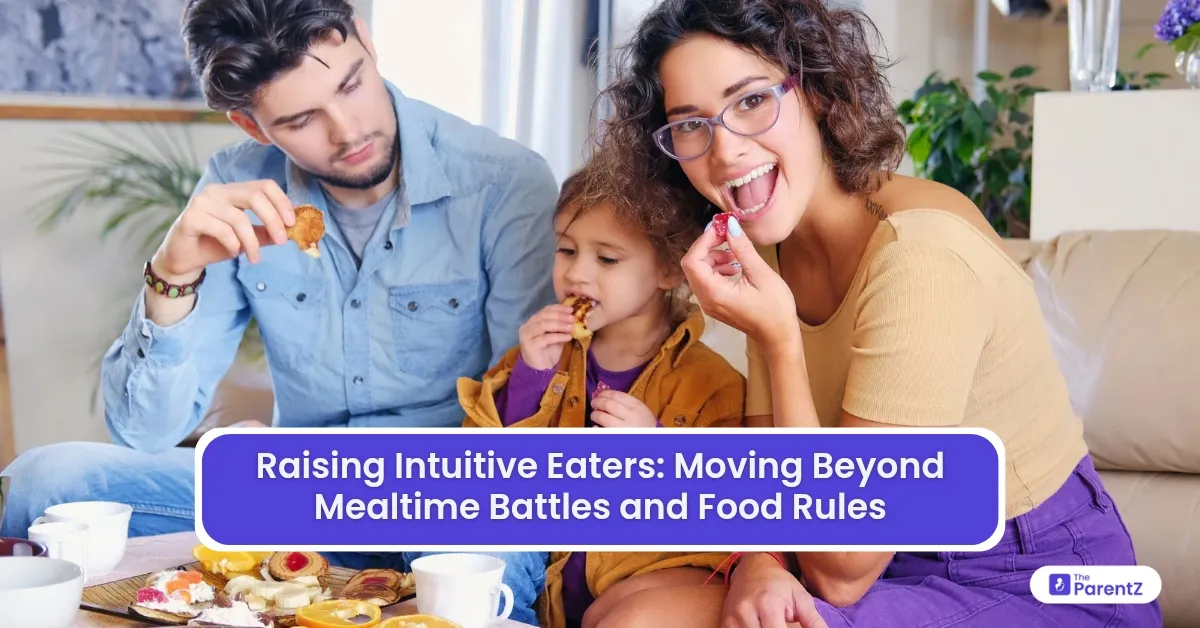If you’ve ever found yourself bargaining over just three more bites or hiding vegetables in pancakes, you’re not alone. Mealtime can be a struggle—one filled with power plays, picky eaters, and the echo of well-meaning rules like “Finish your plate” or “No dessert until you eat your broccoli.”
But what if feeding your child could be more about trust and less about control? What if they could learn to listen to their bodies and not food rules?
That’s the heart of intuitive eating. Read this article to know more about intuitive eating for kids and how you can move beyond just mealtime battles and food rules.
What Is Intuitive Eating for Kids?
Intuitive eating is not a trend or a diet. It’s an approach to food rooted in self-awareness, not restriction. It teaches children to recognize their hunger cues, respect fullness, and enjoy all foods—without guilt, bribery, or shame.
Infants are naturally intuitive eaters. They cry when they’re hungry, turn away when they’re full. Somewhere between sippy cups and soccer practice, those signals can get overridden—by praise for clean plates, pressure to eat more (or less), or fear-based food messages.
When we step in too often, we teach children to tune out their own bodies. And that’s where the struggle begins.
Why Food Rules Can Backfire
While rules around sugar or vegetables often come from a place of love, they can set up long-term food confusion. Saying “Cookies are bad” may create guilt around enjoying them. Pushing greens with “Eat this or else” may associate healthy food with punishment.
Children may become disconnected from their hunger cues, eat emotionally, or rebel through food. Over time, the table becomes a place of tension, not nourishment.
Ditch the Battles: What to Do Instead
Let’s be clear: You’re still the parent. You still decide what comes into your kitchen. But within your structure, your child can have freedom—and that’s where trust is built.
Here are a few principles to raise intuitive eaters:
1. The Division of Responsibility
A concept pioneered by dietitian Ellyn Satter:
- You decide what, when, and where food is served.
- Your child decides whether and how much to eat.
It sounds radical, but it works. Children learn to trust themselves—and over time, most will eat what they need.
2. No “Good” or “Bad” Foods
Instead of labeling food as “junk” or “treat,” try using neutral language: “Cookies are sweet and fun to eat sometimes. Carrots help your body feel strong.”
All foods have a place. It’s about variety, not morality.
3. Normalize Fullness and Hunger
Avoid praising an empty plate. Instead, ask: “Is your tummy still hungry?” or “Do you feel full?” That way, you're supporting their internal signals—not overriding them.
4. Model the Behavior
Your relationship with food is the blueprint your child watches. Do you eat slowly? Do you listen to your body’s cues? Do you enjoy dessert without guilt?
The Emotional Layer of Mealtime
Food is deeply emotional. For many of us, mealtime came with tension or reward. Breaking that cycle means offering your child what maybe you didn’t have: permission to enjoy food without pressure.
That doesn’t mean letting them eat cake for dinner—it means not making cake the forbidden fruit that they long for. When food is de-mystified, it loses its power. Kids become more curious, less reactive.
Real Talk: It’s a Journey
There will be picky phases. Your child might survive on apples and crackers for a week. They might refuse everything green. But if you stay consistent—offer a variety of food, trust their instincts, and take the pressure off—you’re laying the foundation for a healthier lifelong relationship with food.
Remember, mealtime isn’t a report card. It’s a chance to connect, to share, and to nourish—not just with nutrients, but with warmth and presence.
Conclusion
Moving beyond food rules is hard—especially when you’re battling your own childhood messages. But raising intuitive eaters starts with a shift in mindset from control to trust, from rules to respect.








Be the first one to comment on this story.